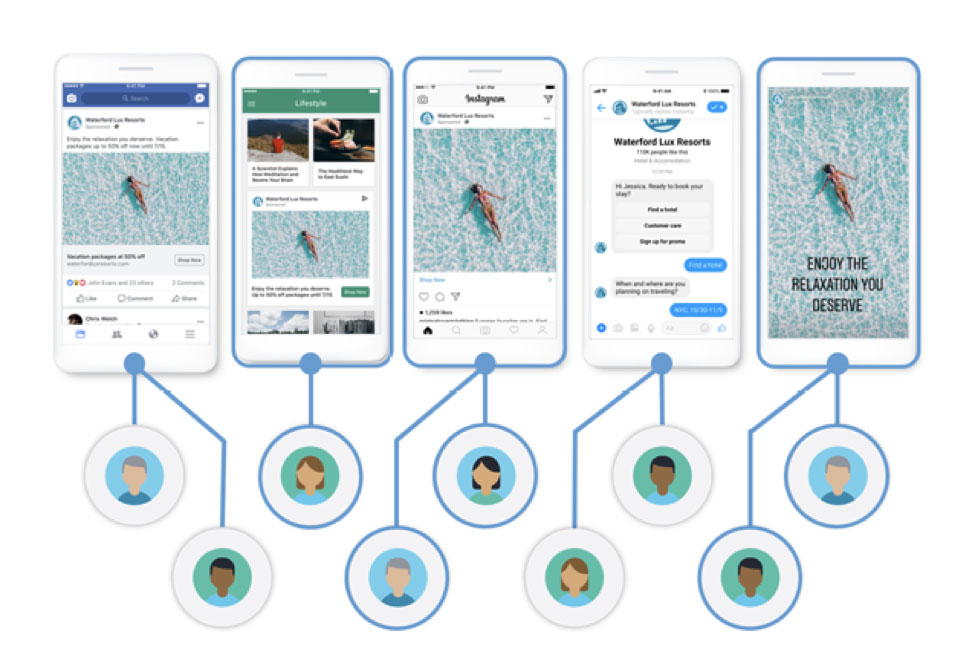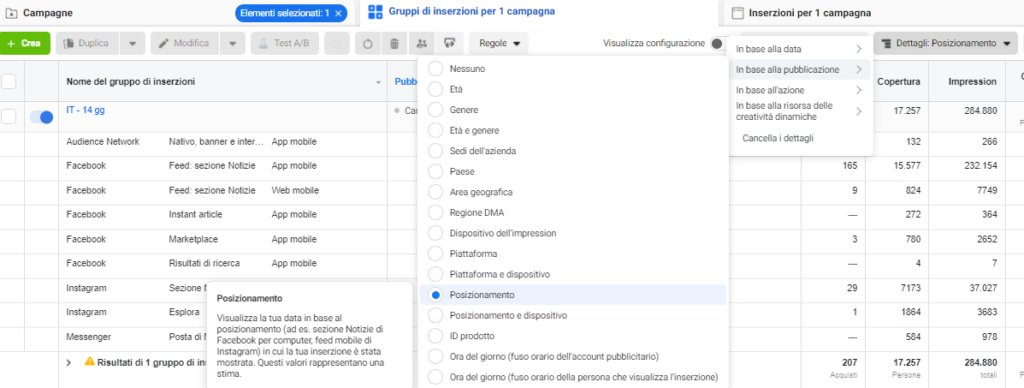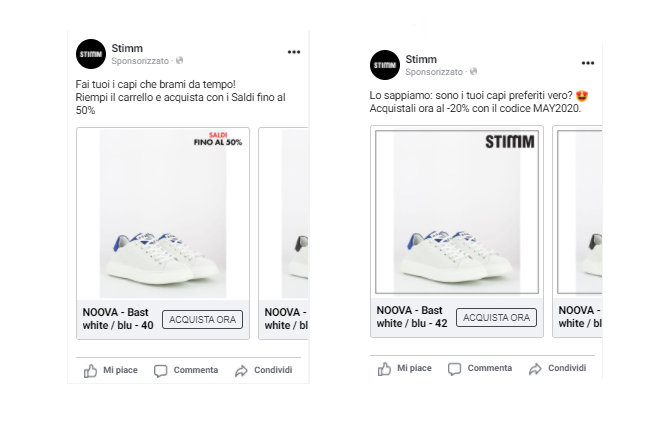When designing an advertisement, the pervasiveness of the promotional message must also be considered among the relevant elements for success. In the digital world, this also means taking advantage of the various “placements”, that is the different places where the advertisements offered by the multiple advertising platforms are shown.

What are the placements?
Before delving into the topic, it is good to know what are the placements that are available today on Facebook, Instagram, Audience Network and Messenger.
1) Facebook
- News section: one of the main and most used placements, as it is the place where users scroll through the news published by friends and from the pages they follow, interacting, commenting or sharing posts.
- Instant Articles: real advertisements that open within the App, without having to open browser windows.
- In-stream video: it shows 5-15 second video ads to users who are watching other videos on Facebook, in particular within the suggested video feed and in the Facebook Watch feed. This type of content is the most effective for creating low-cost, high-quality engagement, while also offering ample opportunities to create customized audiences of users to target real remarketing actions with new advertising campaigns.
- Right column: considered a desktop-only format, it is particularly used for remarketing campaigns aimed at an audience that generated traffic to the site. Not being taken into consideration in lots of cases, it still allows to be present for a niche of users browsing from desktop.
- Facebook Stories: Ads that appear in user stories on Facebook.
- Search results on Facebook: in the latter case, the ads will be shown next to the relevant search results on Facebook and Marketplace. Of course Facebook will measure relevance from the information on the page.
2) Instagram
- Instagram feed: the ads in this case are displayed in the News section only by users who browse from the App.
- Explore Instagram: unlike the Instagram feed, this is a particular section where users can discover photos and images, often of similar accounts they already follow.
- Instagram Stories: as for Facebook, here the ads will appear within the Instagram App. The Stories, launched for the first time on this platform, have further enhanced the relationship between company and user, offering an excellent space to connect with the most loved brands and stay in touch with them, learning about their initiatives, promotions and news.
3) Audience Network
- Audience Network native, banner and interstitial advertisements: these advertisements are shown in the Apps and websites of the Audience Network that Facebook makes available to reach users even outside the platform.
- Audience Network Rewarded Videos: Ads are shown as videos to users in exchange for a reward in an App.
4) Messenger
- Messenger Mail: Ads are displayed on the Messenger Home tab.
- Messenger sponsored messages: in this case the ads are displayed as messages received by users who have already come into contact with the brand on Messenger.
- Messenger Stories: Ads that appear in users’ stories on Facebook.
Which placements should you choose?
The choice to consider only some of the placements from the list depends on several factors, including the type of audience you are targeting or the objective of the campaign. Facebook usually recommends using automatic placements, which offer the advantage of optimizing campaigns more efficiently and obtaining better results, primarily in terms of cost containment, but also on performance.
A crucial aspect is the analysis of the performance obtained by each individual positioning within the campaign, as this will help to allocate resources in the best possible way in future campaigns.
For example, the choice to use the Audience Network as a positioning – and therefore to convey the message also to external Facebook sites – is at first glance an excellent opportunity to preside over an additional channel, especially when dealing with campaigns. oriented towards engagement or App installation. With campaign objectives different from these, in fact, there is a risk that poor quality traffic is generated, resulting in poor performance. It is therefore always good to test the different positions with some attention and constant monitoring.
The same thing goes for Stories: telling stories optimized for mobile is definitely a means to increase the efficiency of campaigns even more. If we then consider the data – 500 million users who use Instagram Stories and 300 million who use Facebook Stories every day – it goes without saying that the choice to exploit this immersive format is certainly optimal, as the ad will have a rather high percentage to be displayed. Obviously it will be necessary to understand if in the specific case this positioning actually brings benefits.
How to analyze the effectiveness of the placements?
Understanding which placements record the best results in a campaign is simple: you need to access the Business Manager, go to the ad group of the campaign and then click on the right on “Details”> “Based on publication”> “Positioning” (As in the image below).

What about creativity for Facebook Ads?
However, the choice of some placements, including automatic ones, also implies numerous graphic adaptations of the image chosen for the advertising campaign, often requiring more time and, consequently, money. In fact, each placement on the Facebook network has different image dimensions, aspect ratios and requirements: an ad might look good on the Facebook feed, but potentially not be suitable for Instagram Stories.

Facebook Ads, however, offers the solution, guaranteeing automatic image adaptation and saving you a lot of time. This novelty is actually not very recent, as it is a feature released in 2018 by Facebook Inc. Therefore, there is only one recommendation for Facebook Ads to be effective: choose images of excellent quality, with good levels of contrast and brightness, and especially with the subject of the image positioned in the center, so as to avoid automatic cropping that could completely or partially exclude the protagonist.
The case is different for creatives on dynamic remarketing: being a campaign linked to a product catalog, it is not possible to customize every image of each product, even if the platform offers other “dynamic” customizations that can make posts more visible to users during disinterested scrolling of the feed.
Some of these are:
- the display of the price in the corner of the image, which Facebook automatically modifies for each individual image of the product, being information obtained from the catalog;
- the motif, that is a graphic with a transparent background that is inserted above the basic image of each product, used to create a frame, insert a logo or a text message (to communicate, for example, what are the delivery times).

In both cases it will be possible to choose where to place the price or the logo based on the image of the starting product (ex: top right, center, bottom, etc.). In this regard, it is important to remember to upload the patterns with a transparent background, so that they do not cover the product images.
Finally, summarizing, when an in-depth analysis has found which are the best performing placements and the right creativity for each placement, that’s it! Your ads will be more relevant, more engaging, and will likely increase performance across placements. Using as many placements as possible is still good practice, but should always be monitored.